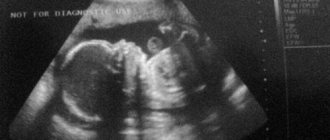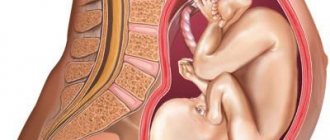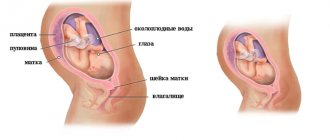The expected due date is at the end of this week. The condition of the expectant mother at 40 weeks can be described in one word - “expectation”. The baby, whose weight is about 3.5 kg and height is 48–51 cm, has long been ready for birth. All that remains is to wait for the moment when he makes mom and dad happy with his appearance.
How many months is this?
Your pregnancy has reached 40 weeks, which means that 38 weeks have passed since the conception of the child, that is, nine and a half months (about the timing and calculation rules).
Content
- Introduction
- 40th week of pregnancy: How it feels
- Fetal movement at 40 weeks of gestation
- External changes at 40 weeks of pregnancy
- 40th week of pregnancy: Precursors of labor
- Complications and problems at 40 weeks of pregnancy
- Fetal development at 40 weeks of gestation
- 40th week of pregnancy: Tests and studies
- Nutrition at 40 weeks of pregnancy
- Physical activity at 40 weeks of pregnancy
- 40th week of pregnancy: Recommendations from a gynecologist
- Sex at 40 weeks pregnant
- Conclusion
Frequently asked questions on the forums
1:
V.: I’m 40 weeks pregnant, this morning I have pain like menstruation. Maybe I'm giving birth?
A: Such pain may be a symptom preceding the onset of contractions. Observe your condition, if cramping sensations appear, which are regular and become more frequent over time, then immediately go to the maternity hospital. Training contractions may also present with the same symptoms.
2:
V.: Week 40 has begun and there are still no signs of labor (second birth). When will I give birth?
A: Precursors of labor in a second pregnancy may appear several days before birth, or even a few hours (everything is very individual). The second birth takes place more quickly, so the harbingers appear much later.
3:
Q: My water has broken, but there are no contractions (40 weeks). What to do?
A.: The waters often break several hours before the contractions begin, if we talk about the complete rupture of the waters. If contractions do not begin after several hours, go to the maternity hospital; labor may have to be stimulated. Also, at 38-40 weeks, leakage of amniotic fluid occurs, when it comes out in small quantities. This happens often and is not something terrible, but you should definitely see a doctor for an examination.
Fetal movement at 40 weeks of gestation
The expectant mother feels the movements of her baby just as well as before. However, the baby is no longer as active as in the past. Now it is difficult for the child to move in the uterus, since he has almost completely occupied it, for this reason he sleeps almost all the time and trains the sucking reflex on his thumb.
The strongest and most uncomfortable shocks occur in the subcostal area, since this is where the baby’s legs rest. This happens when the baby wakes up and tries to move its legs to warm up. The most pleasant and unusual sensation is the slight vibration of the skin on the abdomen, which occurs as a result of the child hiccupping. To understand whether everything is normal with the baby, the expectant mother should count the number of his movements, which normally amount to ten pushes in twelve hours.
You can also find out what happens at 41 weeks of pregnancy, how the baby develops and moves, what gynecologists recommend and much more. You can find all the necessary information in this article.
Weight gain and nutrition
With a normal body mass index (from 19 to 26), weight gain of about 13-15 kg is allowed. With a body mass index above 26, a woman should gain no more than 9-10 kg. Proper nutrition helps maintain normal weight during pregnancy.
We invite you to familiarize yourself with the products recommended at 40 weeks:
- All porridges (buckwheat, rice, oatmeal, wheat, corn).
- Vegetables and fruits (except new exotic ones).
- Low-fat varieties of fish and meat, preferably boiled.
- Dairy and fermented milk products.
- Biscuits, dry biscuits, wholemeal bread.
- All types of greens, salads.
- Eggs and nuts in limited quantities.
- Natural juices, herbal teas, plain water.
Nutritionists recommend avoiding sour, smoked, salty, spicy foods, sausages, ketchups, and mayonnaise. Allergenic foods should be introduced into the diet with caution. These are eggs, chocolate, nuts, citruses. Sweet pastries and baked goods will also not bring much benefit. For sweets, you can take halva, a small amount of honey, marshmallows, marmalade.
Think about your breastfeeding diet now. Read our article on this topic.
External changes at 40 weeks of pregnancy
The height of the uterine fundus at this stage is approximately forty centimeters. Due to the fact that the child is constantly increasing in size, the abdomen becomes so large that the skin on it stretches very much, which, if not properly cared for, leads to the appearance of stretch marks.
If you carefully monitor the baby's movements, you will notice which part of his body is visible through the skin of the abdomen. Most often, the outlines of the lower extremities and head appear.
In the fortieth week, training contractions appear daily. With their help, the body prepares the uterus for easier childbirth by straining and contracting its muscle fibers. The uterus moves into the pelvis, and along with it the abdomen, which used to be under the breast and compressed the diaphragmatic region, also descends.
Since the uterus has descended into the pelvis, the woman notes that it becomes easier for her to breathe and her heartburn, which has tormented her since the second trimester, disappears. At this time, the skin on the abdomen begins to itch and hurt; to avoid this, it should be moisturized with special lotions for stretch marks.
A large belly makes it difficult to move. In addition, movements are no longer fast and free as before, so when walking in the park, a woman must be very careful not to fall and get injured. To avoid this, it is best to walk in the company of your husband or girlfriends.
What happens to a woman
The 40th week of pregnancy is the home stretch. This period is considered quite difficult, because accumulated fatigue makes itself felt more and more. Training contractions become more frequent and painful. Mommy is overcome by drowsiness, often suffers from insomnia and chronic fatigue. Walking is quite difficult, shortness of breath occurs.
The breasts increase significantly in size and colostrum is released. There are special bras designed for pregnant women. They are equipped with gaskets to help prevent your clothes from getting dirty. The dermis in the area of the mammary glands and abdomen may be very itchy. Baby cream or natural oils will help you cope with this.
By this time, a woman gains up to 15 kg. This is considered normal for a body mass index of 16-19. With a BMI over 26, a pregnant woman should gain about 9-10 kg. It is very important to monitor your weight gain. Extra pounds can negatively affect the birth process and the general well-being of the girl.
Complications and problems at 40 weeks of pregnancy
Pain and discomfort bother the expectant mother throughout the entire period of gestation. They are caused by the growing load on the body caused by the enlargement of the uterus due to the fetus growing in it. Also, pain is associated with divergence of the pelvic bones and the appearance of edema in the lower extremities.
Most often, pain occurs in:
- Abdominal area due to training contractions;
- Lumbar and perineum;
- Lower extremities due to swelling and impaired blood flow;
- Anus due to inflammation of hemorrhoids;
- The pelvic area due to the divergence of the bony joints of the pelvis for the smooth passage of the baby through the birth canal.
If the pain intensifies, you should inform your gynecologist; perhaps it is associated with some complications. If they really occur, the woman is sent to the maternity hospital for artificial delivery.
Vaginal discharge at 40 weeks of pregnancy
At the fortieth week of gestation, the discharge may increase slightly. If a woman notices a dense clot of mucus with blood streaks, then most likely the mucus plug has come off, which protected the baby throughout the entire pregnancy from pathogenic microflora that could enter the uterus. Shortly before the baby is born, the plug comes out to allow the baby to be born.
If the discharge at the fortieth week of gestation becomes too watery or bloody, the woman needs to pack her things and go to the maternity hospital. The discharge of amniotic fluid is evidence of the imminent birth of the baby, and the release of blood may be evidence of placental pathology.
To make sure that everything is fine with the child, you need to contact a gynecologist who will conduct an examination and identify the cause of the problem.
Complications
With the onset of the fortieth week of gestation, the risk of developing various complications increases. For this reason, a woman should be under the supervision of a doctor and visit an antenatal clinic weekly.
The most common complications this week are:
- Oxygen starvation of the fetus;
- Thrush, which often occurs in expectant mothers;
- Placental abruption;
- Preeclampsia.
The greatest danger at this stage is late toxicosis. When this pathology occurs, the woman complains of high blood pressure, nausea, severe weakness, vomiting and swelling. If the expectant mother notices similar symptoms, she should immediately seek help from a specialist.
If gestosis is detected, gynecologists refer the woman to induction of labor or cesarean section to avoid death, which can affect not only the child, but also his mother.
Incorrect position of the fetus in the uterus
In the normal course of gestation at forty weeks, the baby should already be in the correct position in the uterus, turning head down. This position will allow him to be born smoothly without any injuries or complications.
However, there are times when the baby does not take the desired position and is positioned either across the uterus or remains in a feet-first position. In this case, in order not to take risks, doctors send the woman for a caesarean section. But sometimes, if the baby is small and there is no umbilical cord entanglement, the expectant mother is allowed to give birth naturally.
Norm CTG
Cardiotocography is a diagnostic technique that allows you to find out the condition of the fetus at any stage of pregnancy. The data is recorded on a special tape, which gives the specialist the opportunity to assess important criteria for the child’s well-being.
Normal CTG indicators:
- The baby's heart rate is 120-140 beats/min. Minor deviations up or down are allowed, depending on the behavior and well-being of the mother.
- A heart rate above 160 indicates tachycardia.
- Heart rate below 120 beats/min is sinus bradycardia.
- With a frequent decrease and increase in heart rate, the baby is diagnosed with sinus arrhythmia.
- Heart murmurs in a child occur for reasons such as cardiac pathologies in the mother, Rh conflict, late toxicosis and other conditions.
Data obtained during the study should be assessed exclusively by a specialist. Other tests must also be taken into account.
Fetal development at 40 weeks of gestation
The size of a baby at the fortieth week can be compared to a small pumpkin. Now his weight is 3500 grams, and his height ranges from 48 to 51 centimeters. The obstetric age of the fetus is forty weeks, while the embryonic age is only thirty-eight. The embryonic period is not counted from the first day of the last menstrual flow, but from the moment when the fertilized egg is attached to the wall of the uterus.
From the first day of its development until forty weeks, the baby has gone through the full stage of development from one cell to a full-fledged person who is waiting for his time to be born.
In the baby's lungs there is a special substance - surfactant, which allows them to open and give the baby the first breath after birth. The stomach and intestines work at full capacity, digesting the amniotic fluid, which the baby swallows during breathing exercises. The digested remains of amniotic fluid accumulate in the intestines, transforming into original feces, which the baby will defecate in the first days after birth.
Baby's internal organs
At this stage, the child has developed and works the grasping and sucking reflex, which the baby trained throughout his entire stay in the uterus. He felt and explored his umbilical cord and sucked his thumb while sleeping so that after birth he would be able to find his mother's breast and put his skills into practice.
The organs of hearing and vision are already fully formed and perform the functions assigned to them. The baby can focus on objects that interest him; he distinguishes between brightness, volume, colors and contrast.
Every day it becomes more and more difficult for the placenta to perform its functions and supply the baby with oxygen and the substances it needs. Its cellular structures begin to thin and age. It is for this reason that immediately after birth, the baby’s skin has a bluish tint and a wrinkled appearance. These are signs of lack of oxygen. But there is no need to worry about this, everything will be back to normal in a couple of days.
The baby's reproductive and urinary systems are already fully formed. The testicles in boys have completely descended into the scrotum from the peritoneal space. The girls also developed ovaries, a uterus and a vagina.
The bone structures of the skull are still flexible and soft. They must remain such that the baby’s head can easily pass through the narrow birth canal without any difficulties.
Nutrition at 40 weeks of pregnancy
At the fortieth week of gestation, a woman should eat only high-quality and natural products that will be beneficial to both her body and the body of the child. We should not forget that the menu should contain vitamins, which can be obtained from fruits, vegetables and herbs. In addition, the expectant mother should drink a vitamin and mineral complex prescribed to her by a specialist at the beginning of pregnancy.
Before giving birth, a woman needs a lot of foods containing vitamin K, which will improve blood clotting, preventing bleeding during labor. You should include dairy products, broccoli, green onions and spinach in your diet. This vitamin is also found in green and black tea, olive and soybean oil.
You need to think in advance about how to prepare the body for lactation, which should begin immediately after birth, since the baby will need milk. To do this, your menu should be diversified with beef, chicken and fish. It is necessary to exclude from it salty, smoked and spicy foods, coffee and alcoholic drinks.
Harbingers of childbirth
At 40 weeks, almost all women exhibit characteristic signs indicating the imminent onset of labor; they are also called harbingers of labor. Here are some of them:
- My stomach dropped. Closer to the date of birth, the baby drops lower, the head is pressed tightly against the pelvis, thus the baby is preparing to be born.
- Periodic pain in the lower abdomen. A woman may occasionally experience unpleasant but tolerable abdominal pain. These are training contractions: the stomach turns to stone for a few minutes, the lower abdomen pulls and the lower back hurts, and then the pain goes away. Such contractions do not lead to the onset of labor, but they indicate that childbirth is very close, and the body is preparing for it with the help of such training.
- Removal of the mucus plug. A mucus plug is a small amount of mucus that is clear in color and sometimes contains a small amount of blood. Such a plug protected the child from various infections, but now, if it comes off, labor can begin immediately, or maybe in a few days. A woman should exercise caution, due to the fact that the child is susceptible to various infections when the mucus plug ceases to perform its function.
- Decreased fetal activity. Just before birth, the fetus inside calms down, and the number of baby movements decreases, because the baby is preparing to go through the difficult path of birth.
Physical activity at 40 weeks of pregnancy
Unfortunately, at the fortieth week, active mothers will have to give up training for a while. This period is already quite impressive, so physical activity can negatively affect the body of the mother and child.
Instead of actively visiting the gym and swimming pool, you should walk more in the fresh air. The best place for walks would be a park or a suburban forest plantation. But at the same time, it is not recommended to go far from the city, since labor can begin at any moment.
Also during this period it is necessary to perform breathing exercises, light exercises and Kegel exercises. You should not do too much housework or walk long distances in order to hasten the birth. If the gestation process proceeds normally and there were no threats during it, then labor should begin naturally without any stimulation.
Sex at 40 weeks pregnant
During this period, many couples lead an active intimate life. If the doctor has not placed any restrictions on intimacy, then there is nothing wrong with it; the main thing is to choose positions that completely eliminate pressure on the stomach. In some cases, even the gynecologist himself may advise having sex with the father of the unborn child in order to stimulate labor.
Since male sperm contains prostaglandins, which soften the cervix, intimate relationships will strengthen the tone of the cervix and contribute to the approach of labor.
However, if the partner has any infectious disease of the genital area, you should not have sex, as there is a possibility of infection of the baby. In any case, permission for intimacy in the fortieth week can only be given by a doctor who monitors the expectant mother and knows how her pregnancy is progressing.
Symptoms of childbirth. When is it time to go to the hospital?
Often, labor can begin with the rupture of amniotic fluid.
As a rule, it is a clear, odorless liquid. The volume can be approximately 200 ml. In this case, you can calmly get ready and go to the maternity ward.
If the liquid has a greenish or grayish tint, then you need to hurry to avoid hypoxia. Doctors will be able to help mother and child in time.
When the water breaks, regular contractions may begin - contractions of the muscles of the uterus, which push the baby out.
Labor pains are accompanied by significant pain in the lower abdomen and lumbar region. The abdomen at this time becomes very hard for a short period of time.
Real prenatal contractions are regular and are accompanied by clear intervals. Gradually, the intervals become shorter, and contractions occur more frequently.
Doctors consider the optimal time for the expectant mother to appear in the maternity hospital to be an interval of 7–10 minutes.











